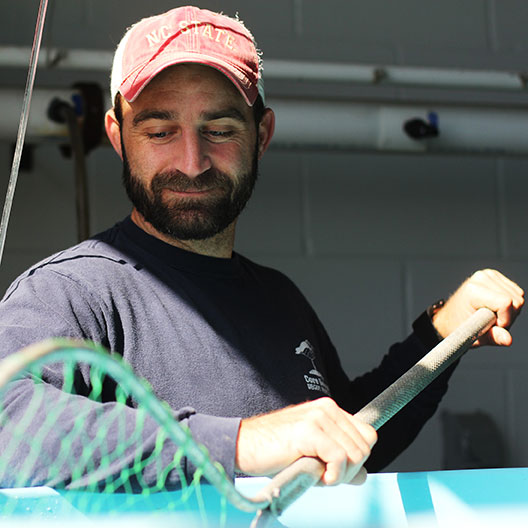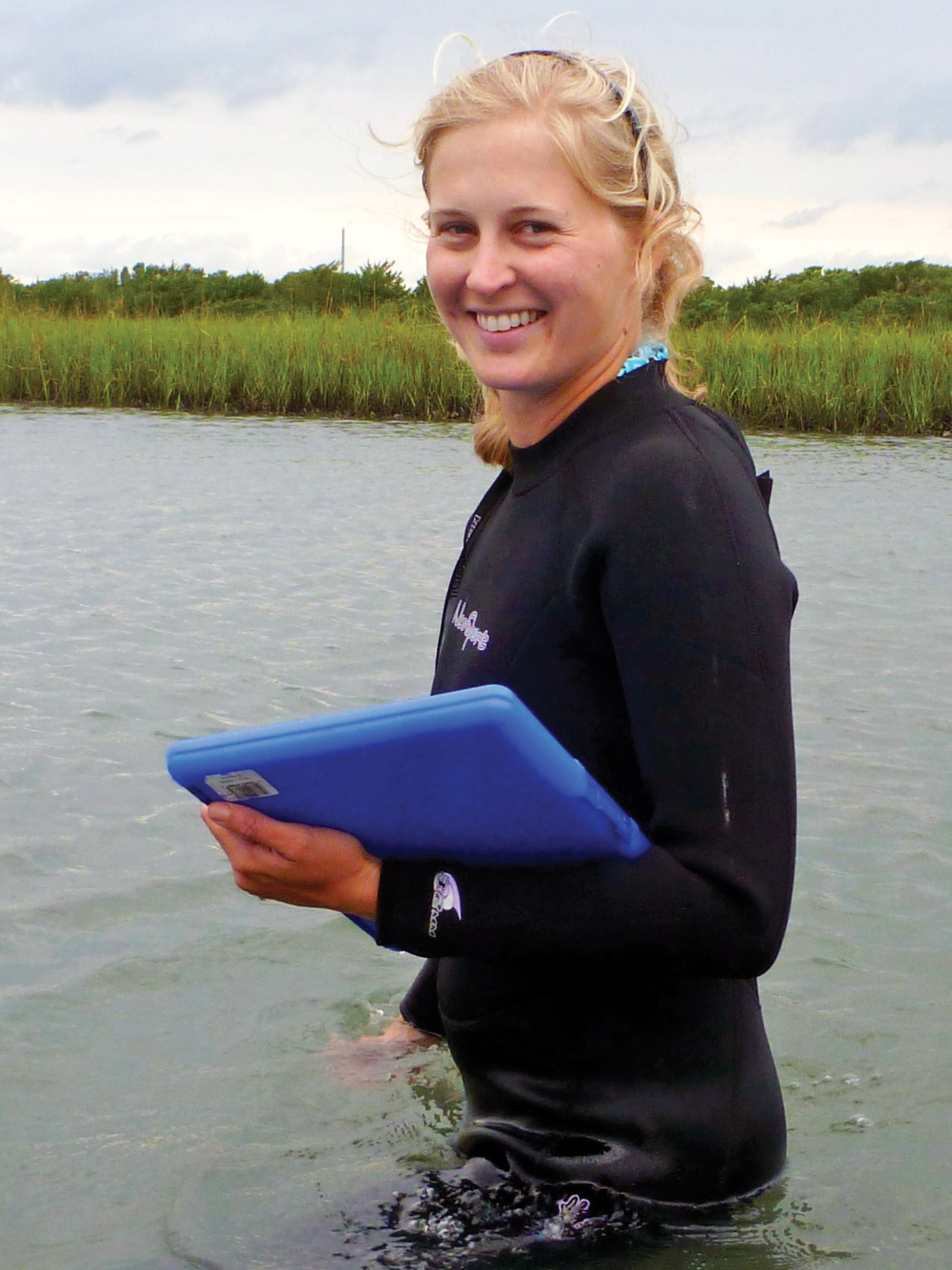Student Achievements and Awards
Student Achievements and Awards
- Impact Awards
- Undergraduate Awards
- Dissertation Completion Fellowship
- UNC Awards and Fellowships
- Outside Fellowships
Impact Awards from the Graduate Education Advancement Board at UNC-CH:

|
2021: Diamond Holloman ‘I Didn’t Want to Be a Victim’: Examining Grassroots, Long-Term Hurricane Recovery |
Disaster management strategies typically focus on the ways in which governmental and non-governmental agencies work to recover and repair physical damages following disaster events. In North Carolina especially, disaster recovery – namely, after hurricanes – is connected to both ecological and sociohistorical factors that relate to racial and ethnic marginalization, power and grassroots action. Focusing on the aftermath of Hurricanes Matthew (2016) and Florence (2018) in Robeson County, N.C., my research examines the relationship between vulnerability, resilience and adaptation in African-American and Native American (Lumbee) neighborhoods. Using interviews and photography, I document the social aspects of living within African-American and Lumbee communities in Robeson County in the wake of disaster. These neighborhoods are situated in more flood-prone areas, as well as subjected to less financial aid and fewer resources in response to hurricanes; this dual form of ecological and social erosion of local response capacity makes it harder for them to successfully recover. My research demonstrates that African-American and Lumbee communities note the gap between government assistance and their needs and strategize beyond narratives of vulnerability to provide for themselves and their communities in order to recover from hurricanes. I then examine grassroots action and mobilization as a mode of adapting to changing climates that is under-examined. Grassroots organization following disaster is a key component of these communities’ recovery and resilience strategies. Modeling an approach that emphasizes this creates more comprehensive, sustainable plans for communities of color in North Carolina, and potentially across the United States. |
|

|
2020 - Horizon Award Recipient: Shelby Ziegler Understanding How Fish Adapt to Coastal Change, to Help Fishing Industries “Shelby’s data highlight that marsh size and shape are important controls on the role of this habitat for ecologically and economically prized fishes. The conservation and restoration applications of these data should be significant,” said adviser Joel Fodrie, Ph.D. |
In today’s world, there are ever-increasing demands placed on marine and coastal habitats. North Carolina’s coastal habitats provide many essential services to humans and support a large economic driver in our state: our commercial and recreational fisheries. Despite their vital role, very little is understood about how the area of any one particular habitat relates to a given amount of fishery production. Tidal wetlands — otherwise knowns as marshes — are believed to serve as key habitat for many commercially and recreationally valuable fishes and crustaceans. Approximately 90% of the fishery species commercially harvested in North Carolina are considered ‘wetland-dependent.’ However, over the past 200 years, upwards of about 30% of coastal marshes have been lost due to a variety of human-induced stressors. This has resulted in the breaking apart of previously continuous tracts of habitat. My dissertation research focuses on understanding how ecologically and economically important fishes and crustaceans use different types of marsh habitats as foraging areas to obtain energy and grow, and how fishery species respond to coastal habitat change, including degradation or loss of marshes. My dissertation work offers valuable insight into how these coastal habitats vary in support to fishes and crustaceans geographically. This provides key information to fishery managers toward the conservation and restoration of marshes to best enhance economically valuable species and sustain lucrative fishing industries in North Carolina and beyond. |
|

|
2020: Matt Kenworthy Using Emerging Tracking Technologies to Identify Healthy Habitats for Fish “Matt’s research has expanded the tool-kit for describing the complex – but centrally important – ways in which large fishes depend on estuarine habitats. I anticipate his findings will be used to prioritize areas/habitats most important to conserve for the health and productivity of our estuaries,” said adviser Joel Fodrie, Ph.D. |
“Estuarine habitats such as saltmarshes, seagrasses and oyster reefs are important for the growth, reproduction and survival for many of North Carolina’s recreationally and commercially important fish species. Unfortunately, these habitats are exposed to negative stressors, resulting in loss and degradation of these valuable resources. There is a need to identify habitats that are most conducive to producing healthy fish populations so coastal resource managers can develop and implement effective conservation efforts. Fundamental to such initiatives is understanding how fish use and move among different habitats over tidal, daily, seasonal and life-time scales. My dissertation incorporated an emerging technology, acoustic telemetry, to monitor fish movement and habitat use. This approach has greater resolution in time and space than some traditional methods such as net- and trap-based surveys. By tracking individuals from three recreationally and commercially important fish populations (red drum, black drum and southern flounder), my research provides managers with: (1) a better understanding of estuarine-scale movement and habitat selection by fishes in targeted N.C. estuaries, (2) fine-scale habitat preferences within estuarine seascapes, and (3) the value of restored oyster reefs as habitat for these fish species. Outcomes from these studies are being utilized by coastal managers to develop targeted conservation initiatives designed to preserve the most critical habitats for estuarine fish species.” |
|

|
2018: Danielle Keller Understanding How Habitat Features Affect Fish and Crustacean Populations "I expect that Danielle's work will be influential in the next draft of North Carolina's detailed Coastal Habitat Protection Plan in terms of oyster reef and seagrass management." said adviser Joel Fodrie, Ph.D. |
North Carolina has an expansive estuarine system with many critical habitats for young fishes and crabs. However, estuaries are also among the most degraded ecosystems on the planet. The loss of habitats, such as oyster reefs, salt marshes and seagrass beds, has impacted the nursery-related functions of our estuaries, which is a major economic and environmental concern in North Carolina. Doctoral student Danielle Keller led three efforts to better understand links among habitat quality, availability and fishery production.
Specifically, she monitored species density and foraging behavior to determine how fauna respond to changes in habitat availability. Keller determined which species of fishes and crabs appear to benefit most from increasing the amount of structurally complex habitat within the estuary. In turn, these findings provide insight into how declines in estuarine habitats may have reduced the fishery production of North Carolina’s coastal ecosystems. Keller also led an effort to restore oyster reefs along different types of salt marsh shorelines, and found that the shoreline with the lowest wind and wave energy supported higher adult oyster densities. Lastly, Keller monitored the density and movement of fishes in different types of seagrass beds, finding a strong decline in fish densities coinciding with a seasonal decline in eelgrass cover, even as another species, shoalgrass, increased in cover. As eelgrass finds its southern range limit in North Carolina and experiences seasonal thermal stress, these data highlight how climate change may impact fishery production in our estuaries. Taken collectively, state managers and the N.C. Coastal Reserve and National Estuarine Research Reserve will be able to leverage Keller’s findings to better design restoration projects to maximize fisheries production and shoreline protection for coastal citizens. |
|

|
2017: Adam Gold Stormwater Ponds and Their Connections to Coastal Water Quality "Adam's project provides actionable information for coastal water quality managers and improves our understanding of the role of stormwater control measures in coastal nutrient cycling," said adviser Michael Piehler, Ph.D. |
Nitrogen is of great concern to coastal North Carolina: Excess amounts of this nutrient, a byproduct of development, can cause harmful algal blooms and a decrease in water quality. State guidelines and current scientific literature suggest that stormwater ponds permanently remove nitrogen from the environment. Most research guiding stormwater management has taken place in areas other than the coast; guidelines are applied to the coast despite important distinctions in soils and terrain.
Master’s degree student Adam Gold sought to fill a gap in what is known of stormwater ponds by analyzing pond nitrogen removal in coastal North Carolina. Gold’s research took place on Marine Corps Base Camp Lejeune in Jacksonville, as a component of a Defense Coastal/Estuarine Research Program project. He collected sediment cores and water samples from five stormwater ponds encompassing a range of ages. At the UNC Institute of Marine Sciences, his team conducted tests to determine the flux of gases from the sediment surface to assess stormwater pond nitrogen dynamics. Gold’s study showed that stormwater ponds become less effective at permanently removing nitrogen over time and can become continuous sources of nitrogen during the summer as the ponds age. Results from his research indicate that stormwater ponds can add nitrogen during the summer through sediment nitrogen fixation. Additionally, Gold found that the landscape-wide implementation of stormwater ponds in a coastal residential neighborhood was unable to mitigate the negative effects of development on stream water quality, particularly elevated nitrogen concentrations. His results will inform stormwater management in coastal North Carolina. |
|

|
2017: Bianca Lopez The Changing Nature of Urban Forests "Other studies focus on larger urban areas such as New York City, Baltimore and Phoenix, meaning that Bianca's focus on the Research Triangle area will document a new kind of situation. Her work will inform land-use and land management decisions in our area," said adviser Peter White, Ph.D. |
The Research Triangle area’s population has almost tripled since 1980. Some of the development accompanying this growth has replaced forests and created smaller forest patches separated by roads, parking lots and housing developments. During three summers, doctoral student Bianca Lopez focused on the impact of urban development on plants within 50 Research Triangle forest sites next to streams. Lopez found no difference in the number of plant species within urban and rural forests; however, urban forests have more introduced species (such as ornamental plants introduced by the horticultural industry) and fewer species native to North Carolina than rural forests. She also discovered that urban development appears to alter the plant species composition of forests, primarily through changes in local environmental conditions (particularly warmer temperatures) and less movement of seeds among forest patches.
Former doctoral student Liz Matthews, Ph.D., had documented plant species composition at the best remaining examples of forest situated near streams. By comparing urban forest sites to these reference sites, Lopez found that many rare species found in reference sites are absent from urban forests. Native species whose seeds travel only short distances are also found at lower frequencies in urban forests than in reference sites. These results suggest potential challenges for maintaining and restoring native plant biodiversity in urban areas. Lopez has identified plant species that are highly affected by urban development and those that are resilient to this process. Her study findings indicate the need to set aside larger forest patches for conservation to encourage seed movement and buffer the effects of warmer urban temperatures. She plans to share her information with city and state officials to inform forest conservation and restoration policies. |
|

|
2017: Sierra Cameron Woodruff Helping N.C. Communities Plan for Climate Change Sierra has created an entirely new way of evaluating the quality of climate adaptation plans, which can focus on the unique needs and situation of a community. Her ideas have been translated into a handbook for North Carolina communities that are hoping to plan for climate change," said adviser Todd BenDor, Ph.D. |
Rising sea levels, increasing temperatures, heavier precipitation, more intense storms and other signatures of climate change will have profound consequences for N.C. local governments. Many communities across the country and several communities in North Carolina are creating climate adaptation plans, which detail how climate change is projected to impact the area and what actions should be taken to prepare. Doctoral student Sierra Woodruff examined current adaptation planning practice in the United States to identify promising practices and potential weaknesses in these efforts. Specifically, she scored 44 U.S. local climate change adaptation plans on 124 criteria and then conducted case studies and interviews with stakeholders.
Woodruff discovered that these plans drew upon multiple data sources to analyze future climate impacts and that they included a breadth of strategies. Most plans she studied, however, fail to prioritize strategies or provide implementation details. Her findings suggest that to improve adaptation planning in North Carolina, plan authors should 1) provide implementation details such as timelines, costs and evaluation metrics, 2) consider a range of potential future scenarios to most effectively account for uncertainty and 3) coordinate adaptation with existing planning efforts. Additionally, her research suggests that planners and elected officials should be engaged in the planning process. Woodruff has shared her findings with policymakers, practitioners, scientists and students across the state. She has presented her findings publicly, including at the Carolinas Climate Resilience Conference, and is working with multiple stakeholders to create tools they can use to identify and prioritize strategies, and build support for adaptation plans. |
|

|
2016: Dennis Tarasi Invasive Shrubs and Their Influence on N.C. Forests "Dennis is providing comprehensive and compelling evidence as to the impacts of exotic plant species and the pattern of these impacts across the Carolina landscape. This is work that advances our conceptual framework regarding the impacts of invasive species and, in addition, helps inform managers as to where and how to focus their efforts to control invasive exotics," said adviser Robert Peet, Ph.D. |
Native to other regions of the world, invasive plants can disrupt the ecology of natural areas where they are introduced. They affect nearly every area of North Carolina, and the autumn olive and Chinese privet, in particular, have escaped cultivation and increased in frequency and density.
To determine the effects of these invasive shrubs on the state’s forests, doctoral student Dennis Tarasi sampled forested plant communities in North Carolina with varying levels of autumn olive or Chinese privet dominance. His findings showed that the dominance of these shrubs correlated with significant changes in the forests, including the overall loss of native species and a significant decline in young trees. Chinese privet “invasions” corresponded to greater native species loss and structural changes than those by autumn olive. Many invasive species also have been documented as negatively affecting soil and available light. Tarasi assessed changes in soil moisture levels, air temperature and light availability, emphasizing locations that were heavily invaded compared to those with little invasion. He found that the heavily invaded sites were more shaded and cooler across the entire summer. Soil moisture did not appear affected. Tarasi then removed invasive shrubs from several sites in his study; this action increased light availability and air temperature with little effect on soil moisture. Land managers, scientists, policymakers and many others can apply Tarasi’s research and methods to manage ongoing invasions. |
|

|
2014: Rachel Gittman What Salt Marshes Can Tell State Leaders "The policy implications of her rigorous and inspired research on how to minimize loss of coastal marsh ecosystem services are wide-reaching and highly significant," said co-adviser Charles Peterson, Ph.D. |
Both state and federal policymakers and managers are using doctoral student Rachel Gittman’s dissertation research as they address coastal management challenges.
Gittman’s interdisciplinary research focuses on the ecology of salt marshes, a vital and increasingly vulnerable coastal ecosystem. As part of her research, she evaluated the effectiveness of different shoreline stabilization approaches in providing the ecosystem services of shoreline protection and habitat for fish and crustaceans. Gittman hypothesized that living shoreline approaches, such as marsh sills (marsh plantings that incorporate a seaward outline of low rocks parallel to the marsh edge), would sustain and enhance ecosystem services provided by salt marshes better than traditional shore stabilization approaches, such as bulkheads. Gittman’s findings indicate that marsh sills can provide better shore protection than bulkheads during storm events, while also enhancing fish habitat. Additionally, based on a nationwide analysis of shoreline data, she found that 14 percent of the U.S. coast has been hardened by some unnatural structure, 66 percent of which has occurred in the Gulf and Southeast regions, where most remaining salt marsh habitat occurs. Gittman recommends that living shorelines be considered as an ecologically preferable alternative to bulkheads for shore protection, particularly in regions with naturally occurring salt marshes. “Rachel’s work is informing coastal homeowners in North Carolina about the best and worst ways to protect their property from storms and sea level rise,” said co-adviser John Bruno, Ph.D. |
|

|
2013: Andrea Anton Gamazo Ecology and Evolution of the Lionfish Invasion of the Caribbean "Her research could prove critical to rescuing North Carolina's high-dollar commercial fishing industry as well as a recreational fishery that engages many North Carolinians and creates high economic value," said advisor Charles Peterson, Ph.D. |
Lionfish have arrived off the North Carolina coast, where they have become one of the most abundant fish predators and a major conservation concern.
Previous terrestrial and freshwater studies have illustrated the devastating ecological effects that invasive predators can exert on naïve prey, including regional species extinction. Doctoral student Andrea Anton Gamazo performed extensive studies of the non-native lionfish’s invasion of marine ecosystems. Her research discovered that numerous fish species do not identify the lionfish as a predator—the most dangerous form of prey naiveté because it prevents anti-predator responses. The lionfish diet includes such species as grouper and snapper, important to the North Carolina coastal economy. The wide distribution of lionfish could have devastating consequences for local fisheries and the state’s economy. Andrea’s research adds crucial knowledge to enhance management of this exotic predator in North Carolina. |
|

|
2012: Kyle Palmquist Protecting Plant Biodiversity in the Longleaf Pine Ecosystem “In addition to conducting her research, Kyle has worked very hard to maximize the extent to which the results will be useful to the stakeholders and to communicate that information directly to them,” said Robert Peet, Ph.D., Palmquist's dissertation adviser. |
One of North Carolina’s richest sources of plant diversity, the longleaf pine ecosystem, is also one of the most threatened.
This ecosystem needs frequent prescribed fire for plants to receive the light, space and nutrients they need to thrive. Doctoral student Kyle Palmquist studied the effectiveness of current fire management practices by re-sampling 59 permanent vegetation plots almost 20 years after they were established. “Prior to this work, there had been no long-term assessment of the stability of biodiversity in longleaf pine communities in North Carolina,” she said. Her study was conducted on Marine Corps Base Camp Lejeune (in collaboration with Duke University), the Green Swamp Wilderness Preserve, a major natural heritage site for the Atlantic coastal plain, and other areas. Findings indicate that frequently burned sites gained the most species over time. Plots resampled on Camp Lejeune and Croatan National Forest had dramatic increases in diversity, whether measured in large or small areas; Palmquist attributed these ecosystem gains to increased burning efforts during the past 20 years, relative to fire frequency in the early and mid-20th century. In contrast, the Green Swamp Wilderness Preserve’s richness was constant at large areas but had strongly declined in smaller areas. The Green Swamp had a history of prescribed fire every year or so until a decade ago, when fire managers decreased burning to every two-to-five years. UNC-Chapel Hill researchers had documented, in the 1970s and 1980s, that the Green Swamp had the highest small-scale richness in plant species ever documented in North America; however, increased drought frequency and reduced fire frequency caused a dramatic drop in plant richness. Estimates place North Carolina’s natural longleaf pine acreage at about 200,000, with little high-quality, frequently burned habitat left. Palmquist’s research has implications for fire management decisions regarding the state’s longleaf ecosystem—and for the biodiversity this ecosystem contains. |
|

|
2010: Elizabeth R. Matthews Piedmont Alluvial Vegetation Robert K. Peet, Elizabeth’s dissertation co-advisor, said that her work promises to increase the success and decrease the cost of on-going wetland restoration programs within North Carolina. Her novel approach is broadly applicable and represents a major improvement over techniques applied across the country for legally required mitigation of wetland damage. |
Few pristine floodplain ecosystems remain in the southeastern United States. Historically, these ecosystems have been home to diverse and highly productive plant communities. Many of these landscapes have been destroyed or degraded, including those in North Carolina. Despite the ecological significance of floodplain plant communities and their current imperiled status, there is little understanding of floodplain vegetation in the state or elsewhere.
The goal of doctoral student Elizabeth Matthews’ research is to provide detailed vegetation information on bottomland hardwood forested wetlands for restoration activities in the North Carolina Piedmont. She collected data in the five major NC Piedmont river basins: the Catawba, Yadkin, Cape Fear, Neuse, and Tar. She used these data to develop detailed, vital records on the composition, structure, and physical setting of the best remaining examples of wetland vegetation throughout the NC Piedmont. Elizabeth’s research has the potential to improve the success of restoration projects across the state. It also may provide a model for other states to develop and disseminate reference information for restoration activities. |
|

|
2003: Bradley Lamphere Seeing the Big Picture Through DNA: A Novel Approach to Link Individual Behavior to Population Dynamics in a Bioindicator Species for Coldwater Streams |
Accurate forecasting of population trends is one of ecology’s great challenges. Current population models simulate birth and death rates well, but generally underestimate the rate of immigration in and out of the population, simply because immigration events are difficult to observe directly. Bradley’s project introduces a novel approach to estimate immigration rates that avoids the underestimation bias present in other methods of assessing individual movements.
Bradley is testing this approach on the mottled sculpin, a small non-game fish, to facilitate its use as a bioindicator species for North Carolina’s coldwater streams. The bioindicator approach uses a species known to be sensitive to the threats facing a habitat like the “canary in a coal mine” to indicate damage to the habitat. From 2000 to 2002, Bradley conducted mark-and-recapture surveys of fish populations in headwater tributaries of the Nantahala River. Among the 1,400-plus fish recaptures, Bradley found individuals moved up to 180 meters, about six times farther than the longest move seen in previous work. Bradley also plans to assess individual movements over 200 meters by using microsatellite DNA markers. Adding long-distance movement data to the data from Bradley’s direct captures will yield a complete picture of sculpin movement from the individual to the population scale. Such a view would improve existing models of sculpin population dynamics and therefore facilitate the species’ use as a bioindicator. In addition, this project will be among the first to integrate genetic data with direct observations to produce realistic immigration predictions. This approach could be useful with many species that feature difficult-to-observe, long-range movements. This project will aid conservation and management efforts and potentially enhance understanding of population dynamics as well. |
|
Undergraduate Awards
2021:
- Emi Mcgeady – Emerging Scholar Award
- Olivia Corriere – Award for All Around Outstanding Student
- Felix Evens – Award for Excellence in Natural Science Research
- Kate Johnson – Award for Excellence in Social Science Research
- James (“J”) Bottomley – Award for Excellence in Social Science Research
2016:
- Zachary Locklear – SACNAS Undergraduate Student Poster Presentation Award
- Andrea Stewart – National Science Foundation Graduate Research Fellowship
2014:
- Oscar Menzer – Phillips Ambassador
- Raymond Stanton – Phillips Ambassador, Pate Scholarship
- Andrea Stewart – NSF Research Experience for Undergraduates Fellowship
2012: Jessica Smith: Phillips Ambassadors Program, Jon Curtis Student Enrichment Fund
2011: Jessica Smith: Carolina Southeast Asia Summer Program
2010: Jessica Smith: Venture for America Fellowship
2005: Dan Waxman – Innovative Environmental Leadership, Hanes Award
Dissertation Completion Fellowship
2017: Danielle Keller
2016: Clare Fiesler
2016: Kaylyn Gootman
2013: Miranda Welsh
UNC Awards and Fellowships
Caroline Patterson: Richard (“Pete”) Andrews Fellow in Environmental Policy
Taylor Gosk: Richard (“Pete”) Andrews Fellow in Environmental Policy
Michael Meeks: Richard (“Pete”) Andrews Fellow in Environmental Policy
Colleen Bove: Graduate and Professional Student Federation (GPSF) UNC Academic Research Conference Honorees GPSF Awards: Oral Presentations
Catherine Alves: Pre-Dissertation Field Research Grant from UNC’s Institute for the Study of the Americas
Lisa Fouladbash: Pre-Dissertation Exploration Award from UNC’s Center for Global Initiatives
Chris Hakkenberg: Center for the Study of the American South Summer Research Grant
Miranda Welsh: Alma Holland Beers Scholarship and Dr. W. C. Coker Fellowship
Miranda Welsh: Dr. W. C. Coker Fellowship in Botany
Outside Awards and Fellowships
Kaylyn Gootman: Geological Society of America Graduate Student Research Grant; The Consortium of Universities for the Advancement of Hydrologic Science Inc. (CUAHSI) Pathfinder Fellowship
Christopher Hakkenberg: NASA Earth & Space Science Fellowship
Danielle Keller: NSF Graduate Research Fellowship Program
Shelby Ziegler: Two-year grant from the NC Division of Marine Fisheries-Coastal Recreational Fish Licensing (CRFL) Program
Catie Alves: NSF Graduate Research Fellowship Program
Chris Hakkenberg: NASA Earth & Space Science Fellowship
Danielle Keller: NC Coastal Reserve – NC Sea Grant College Program / 2016 Coastal Research Fellowship Program, NSF Graduate Research Fellowship Program
Tony Mayer: Garden Club of North Carolina Scholarship , The Corliss KnappEngle Scholarship in Horticulture
Clare Fieseler: Smithsonian Tropical Research Short-term Fellowship
Kaylyn Gootman: Duke Progress Energy Fellowship, CUASHI Pathfinder Fellowship
Chris Hakkenberg: NASA Earth & Space Science Fellowship
Danielle Keller: NSF Graduate Research Fellowship Program
Kaylyn Gootman: Duke Progress Energy Fellowship
Chris Hakkenberg: NASA Earth & Space Science Fellowship
Danielle Keller: NSF Graduate Research Fellowship Program
Chris Payne: Great Lakes National Scholarship
Clare Fieseler: North Carolina Division of Marine Fisheries Commercial Recreational Fishing License Fund Grant
Rachel Gittman: National Estuarine Research Reserve System Graduate Research Fellowship , North Carolina Division of Marine Fisheries Commercial Recreational Fishing License Fund Grant
Chris Hakkenberg: NASA-MSU Professional Enhancement Award, NSF East Asia and Pacific Summer Institutes (EAPSI) Fellowship
Megan Rua: NSF Graduate Research Fellowship Program
Elizabeth Matthews: NC Beautiful Grant
Megan Rua: NSF Graduate Research Fellowship Program
Elizabeth Matthews: NC Beautiful Graduate Fellowship
Mary O’Connor: National Fish and Wildlife Federation’s Budweiser Conservation Scholarship
Erich Hester: EPA-STAR (Science to Achieve Results) Fellowship
Mary O’Connor: National Fish and Wildlife Federation’s Budweiser Conservation Scholarship
Dahl Winters: NSF Graduate Research Fellowship Program
